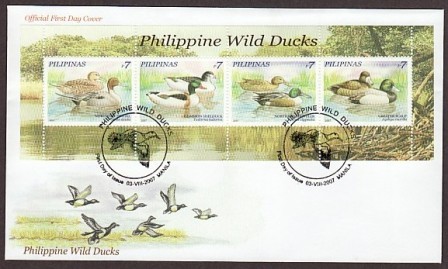2007, August 3. Wild Ducks of the Philippines
(Actual First Day: August 8)
Litho Offset. Amstar Company, Inc. Perf. 14.
Se-tenant Blocks of 4, Miniature Sheets of 16 (4 x 4); Souvenir Sheets of 4
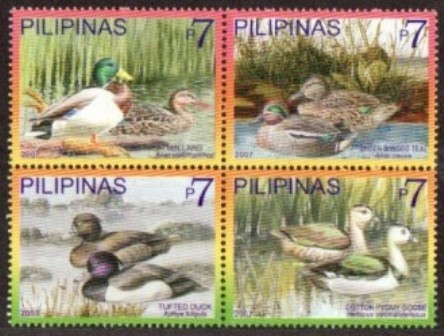
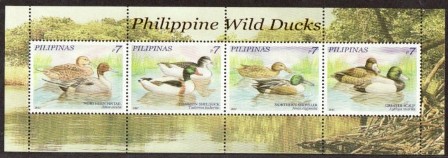
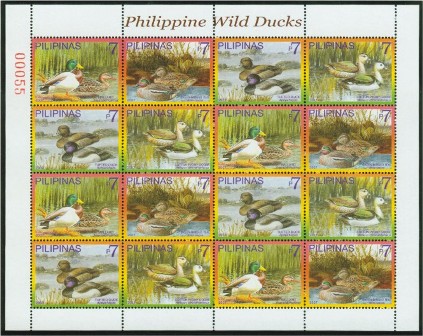
Se-tenant Blocks of Four 16 (50,000)
7p Mallard
7p Green-winged Teal
7p Tufted Duck
7p Cotton Pygmy Goose
Miniature Sheets of 16 (12,500)
Souvenir Sheets of 4 (10,000)
7p Northern Pintail
7p Common Shellduck
7p Northern Shoveler
7p Greater Scaup
Designer: Corazon T. Loza
Graphic Designer: Randolp Siscar, Cristina Metilla, Nick Jr.
Design Coordinator: Dr. Ngo Tiong Tak
Designs: All pictures taken from the book "A Guide to the Birds of the Philippines" by Robert S. Kennedy, Pedro C. Gonzales, Edward C. Dickinson, Hector C. Miranda, Jr., and Timothy H. Fisher.
First Day Covers: Manila
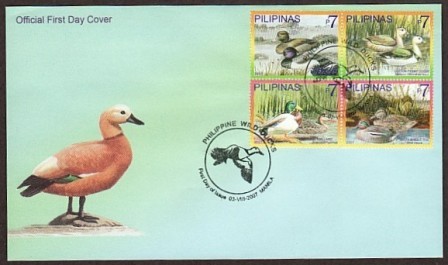
WILD DUCKS OF THE PHILIPPINES
Ducks are web-footed swimming birds in the family Anatidae, which also includes the goose and swan. It is distinguished from the goose and swan by its comparatively small size, short neck and legs, its somewhat flattened body and the sexes usually have a different plumage. In common with them, and with the flamingo, it has transverse, tooth-like ridges called lamellae, just inside the edges of the bill, for straining edible matter from mud or water. The numerous species of ducks occur throughout the world on fresh or salt waters and on many oceanic small islands.
Mallard (Anas p/atyrhynchos). The mallard breeds in subarctic and temperate regions in different countries of the world. It is the ancestor of most domestic ducks and is one of the best known birds in the world. It is usually confused with domestic ducks in ricefields called "quack".
Green-winged Teal (Anas crecca). There are about fifteen species of teal distributed throughout the world. The best known is the green-winged teal which breeds in temperate regions in the Northern Hemisphere. It is a small, fast-flying, surface feeding duck. The male is a beautiful small, gray bird with a green patch on the chestnut-colored head, and a conspicuous, metallic-green patch on the wing. The female is brown speckled with a green wing patch. Uncommon in freshwater wetlands, usually in small groups.
Tufted Duck (Aythya ful/gu/a). Uncommon in open water in deeper lakes and marshes. It is a diving duck and dives for food. It has a unique crests and high foreheads, and white bands in wings extending to first few primaries. Female ducks may have white at base bill and some white undertail, but white eye separates it from Baer's Pochard.
Cotton Pygmy Goose (Nettapus coromandel/anus). Rare, in freshwater lakes and marshes. Feeds on the surface or by diving. Jumps from the water to take flight. Once thought to breed in the Philippines. It is a small sized duck, short bill and plumage are distinctive. It gives a cackling car-car-carawack or quack and weak quack.
Northern Pintail (Anas Acuta). Uncommon in wetlands from marshes to lakes. Males are unmistakable with long thin neck, brown head with white stripe up neck. Female ducks are surface-feeding and has greenish-brown speculum with white trailing edge, long slender neck and longer more pointed tail.
Common Shellduck (Tadorna tadorna). Numerous species of shell duck are widely distributed in temperate and tropical regions of the world. It is a large surface-feeding duck, sometimes known as a Sheldrake. Common shellducks are found in estuaries and fishponds
Northern Shoveler (Anas c/ypeata). All shovelers have a large, shovel-like bill. Uncommon in freshwater marshes and shallow lakes, in pairs or small groups often with other ducks. It has a distinctive large bill which gives a top heavy look and is best field mark for female. Females are also noted with brown belly and give a typical Mallard-like quack look. Males have white breast and chestnut flanks and belly. Males are silent when not breeding.
Greater Scaup (Aythya Marl/a). Usually found in brackish and saltwater bays and estuaries but also in freshwater lakes. It has rounded head and large and broad bill. White in wing extends well into primaries. Male has black front and rear, separated by grey back and white sides is indicative or diagnostic. Females are well-defined white face that differs from female tufted ducks.
-
Wild Life / Ducks
